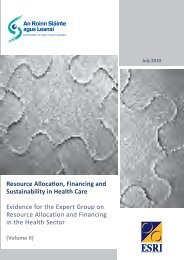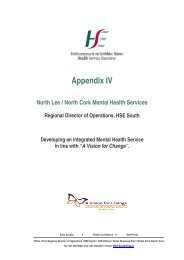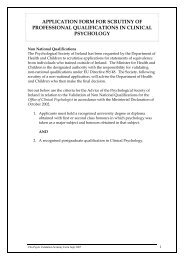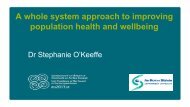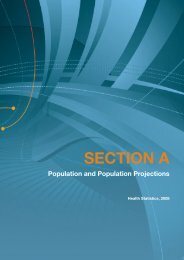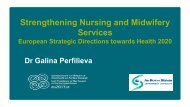<strong>Report</strong> <strong>of</strong> the Commission on Financial Management <strong>and</strong> Control Systems in the <strong>Health</strong> ServiceConsultants’ average pay (¤ 151,694), as shown in Table 7.3, refers to remuneration in respect<strong>of</strong> their 33-hour public contract only. Consultants <strong>of</strong>ten work on-call <strong>and</strong>/or for lengthyperiods outside their core hours as part <strong>of</strong> their public contract commitment. Many Consultantsalso have income from private practice. The <strong>Department</strong> <strong>of</strong> <strong>Health</strong> <strong>and</strong> <strong>Children</strong> estimatespayments to Consultants from private insurers in respect <strong>of</strong> private practice in 2002 amountedto some ¤ 192.5 million. Averaging this over an estimated 1,515 Consultants with privateearnings, including those engaged solely in private practice, suggests an average gross feeincome (before practice <strong>and</strong> other expenses) from private practice in excess <strong>of</strong> ¤ 127,000 perConsultant per annum (this figure does not include fee income paid directly to the Consultantby the patient in the context <strong>of</strong> out-patient visits). Of course, some Consultants have little orno private practice while others will earn a multiple <strong>of</strong> this average.International comparisons <strong>of</strong> pay rates are fraught with difficulty due to a wide variety <strong>of</strong>factors such as differing job specifications <strong>and</strong> terms <strong>of</strong> contract. However, we consider that itis nonetheless instructive to give some indication <strong>of</strong> how the reward structure in Irel<strong>and</strong>compares with, for example, the UK. Consultants in the UK earn a basic salary in the range <strong>of</strong>¤ 80,000 to ¤ 105,000 (Stg£52,640 - £68,505) 4 . A small proportion <strong>of</strong> Consultants in the UKcan earn in excess <strong>of</strong> this through a complex system <strong>of</strong> distinction/merit payments <strong>and</strong> awards.This can bring pay rates up to around ¤ 204,000 (Stg£133,585) based on an A+ distinctionaward. However, considerably less than 1% <strong>of</strong> Consultants employed in the UK’s National <strong>Health</strong>Service receive payment at the A+ distinctions level – in 2001, just 36 consultants. 5Having regard to the foregoing, we fully acknowledge the long <strong>and</strong> unsocial hours worked byhealth care staff in caring for patients. Patients have no control over the time at which theybecome ill <strong>and</strong> are entitled to expect treatment out <strong>of</strong> hours when they need it. Equally, staffare entitled to be recompensed for working unsocial hours.Nevertheless, we believe that the payment <strong>of</strong> overtime <strong>and</strong> other on-cost remuneration on thescale shown in the preceding tables is unsustainable. A significant proportion <strong>of</strong> the work <strong>of</strong> thehealth service is planned, non-emergency work. It should be possible to organise <strong>and</strong> managethis work within core hours. In addition, it has been suggested to us that a much greaterproportion <strong>of</strong> hospital work could be undertaken in day facilities, for example.We consider that a key task for the proposed Executive will be to examine the drivers <strong>of</strong> paycosts with a view to achieving more efficient working arrangements <strong>and</strong> cost savings throughstrategies to reschedule work within core hours <strong>and</strong> tighter control <strong>of</strong> basic pay costs throughthe introduction <strong>of</strong> improved systems <strong>of</strong> manpower deployment <strong>and</strong> control.7.3 NEGOTIATING AND IMPLEMENTING PAY AGREEMENTSThe <strong>Health</strong> Service Employers Agency (HSEA), on behalf <strong>of</strong> health employers, takes the lead rolein negotiations with trade unions <strong>and</strong> representative bodies on the pay <strong>and</strong> conditions <strong>of</strong>employment <strong>of</strong> health service personnel <strong>and</strong> in solving industrial relations problems in thehealth sector. The HSEA was established in 1996. It is a representative body for all publiclyfundedhealth service employers. Its membership includes the health boards, public voluntaryhospitals, intellectual disability agencies <strong>and</strong> such other corporate bodies in the health sector asare admitted to membership. The HSEA provides its services through a Board that isappointed by the Minister for <strong>Health</strong> <strong>and</strong> <strong>Children</strong>. The Board consists <strong>of</strong> nine persons drawn4Source: UK, <strong>Department</strong> <strong>of</strong> <strong>Health</strong> (April 2002). Euro/Sterling exchange rates as at 31 January 2003.5Source:Advisory Committee on Distinction Awards,Annual <strong>Report</strong> 2001, page 6.92
Chapter 7 Accountability – Employment <strong>and</strong> Payfrom the health boards, voluntary hospitals, the <strong>Department</strong> <strong>of</strong> <strong>Health</strong> <strong>and</strong> <strong>Children</strong>, jointboards hospitals <strong>and</strong> intellectual disability agencies. The HSEA has acquired particularexpertise by recruiting to its staff experts from outside the civil service.As indicated in Chapter 3, we would see the HSEA as one <strong>of</strong> the bodies whose functions wouldbe subsumed within the human resource function <strong>of</strong> the proposed Executive.There have been instances where the costs <strong>of</strong> special pay awards were underestimated, sometimes substantially so. Frequently, this is caused by the "spill-over" effects <strong>of</strong> pay agreementswith particular groups not being anticipated at the time negotiations are being finalised by theHSEA. The pay deal concluded with childcare workers, as detailed in Chapter 2, is such anexample. Originally estimated to cost ¤ 4.7 million, it turned out at ¤ 11.4 million in respect <strong>of</strong>childcare workers alone <strong>and</strong> is expected to cost some ¤ 45 million to ¤ 50 million per annumonce the knock-on effects have fed through to linked grades.Pending the establishment <strong>of</strong> the Executive, we consider that there should be some level <strong>of</strong>responsibility with the HSEA for the costing <strong>of</strong> awards negotiated by them while accepting thatultimate responsibility in this regard must rest with the <strong>Department</strong> <strong>of</strong> <strong>Health</strong> <strong>and</strong> <strong>Children</strong>.Our recommendations on risk assessment (see Chapter 8) are also relevant to this issue. Weare also aware that there have been past instances <strong>of</strong> differing interpretations <strong>of</strong> pay agreements<strong>and</strong>, consequently, a lack <strong>of</strong> consistency between health boards in how agreements haveactually been implemented on the ground. In order to ensure clarity <strong>and</strong> coherence betweenthe various agencies involved, it is important that each party have a clear underst<strong>and</strong>ing <strong>of</strong> theirrole during the negotiation stage <strong>and</strong>, subsequently, during the implementation stage.Recommendations on Costing <strong>of</strong> Pay AwardsR7.1 Pending transfer <strong>of</strong> functions to the proposed Executive, the CEO <strong>of</strong> the <strong>Health</strong> Service Employers Agency(HSEA) should report to the Secretary General <strong>of</strong> the <strong>Department</strong> <strong>of</strong> <strong>Health</strong> <strong>and</strong> <strong>Children</strong> <strong>and</strong> be accountableto him for the financial consequences <strong>of</strong> pay negotiations <strong>and</strong> the interim costing <strong>of</strong> agreements conducted bythe HSEA.R7.2 Prior to any agreement being concluded, the final costing <strong>of</strong> pay agreements negotiated by the HSEA should beprepared by the <strong>Department</strong> <strong>of</strong> <strong>Health</strong> <strong>and</strong> <strong>Children</strong>, drawing on the comprehensive dataset proposed atrecommendation R7.6 below.7.4 COLLECTION AND VALIDATION OF BASIC INFORMATIONAt present, the principal data source on employment in the public health sector is the annualCensus <strong>of</strong> <strong>Health</strong> Service Employees. This is a snapshot <strong>of</strong> employment, conducted by all healthboards, on the instruction <strong>of</strong> the <strong>Department</strong> <strong>of</strong> <strong>Health</strong> <strong>and</strong> <strong>Children</strong>, over the last two weeksin each calendar year.The Census is a count <strong>of</strong> all health service personnel. It includes information on employmentcontracts, such as temporary, full-time, locum etc. Employee numbers are reported on by theabsolute number employed <strong>and</strong> are also expressed as whole time equivalents (WTEs) – i.e.converting the number <strong>of</strong> part time workers into an equivalent number <strong>of</strong> full time employees,by reference to the average length <strong>of</strong> the working week.93



